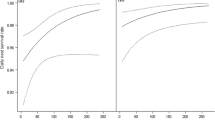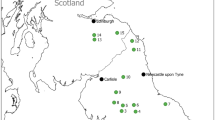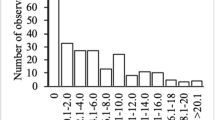Abstract
Farmland bird populations in Europe are shrinking, largely due to modern agriculture practices. In grasslands, the shift to early mowing is believed to be particularly responsible for this decline because it is interwoven with breeding time—a change that birds in general have not adapted to. We studied the post-fledging survival of the Whinchat, an altricial grassland passerine. Based on a sample of 74 radiotagged young Whinchats, we confirmed that they fledge at 13–15 days. Twenty-four fledged birds died, while 18 of them were depredated. The survival probability of young Whinchats, calculated using Kaplan–Meier estimates, was lowest during the first day after fledging, and slowly leveled off later. In total, the probability that a juvenile survived the first month after fledging was 0.52. During the first days after fledging, all chicks were found hiding on the ground among the grass stubble. The generalized linear mixed model predicts that half of the fledglings at 20 days old and 20% at 22 days old (8–10 days after fledging) will not escape but will instead remain still when approached by a threat. Sixteen depredations occurred during this period, all by mammal predators. Afterwards, the fledglings changed their strategy, escaping through flight. After 12 days, more and more of the chicks were found exposed on top of the grass or on the bush instead of hiding on the ground. The transition from sit and hide to escape behavior reduced the predation rate considerably. Only two chicks were depredated later, both by an avian predator. Due to the initial predator avoidance strategy, the current conservation measure (to postpone mowing until the chicks in 80% of all nests have fledged) is not sufficient to halt population decline on improved meadows. We suggest that at least 10 days more, and possibly even 14 days more, are necessary to maintain viable Whinchat populations.
Zusammenfassung
Die Praktiken in der modernen Landwirtschaft führen in Europa zu einer Abnahme der Vogelpopulationen auf Ackerland. Vor allem der Wechsel hin zu früher Gras-Mahd wird dafür verantwortlich gemacht, weil diese immer häufiger in die Brutzeit fällt—eine Veränderung, an die sich die Vögel nicht anpassen konnten. Wir untersuchten das Überleben in der Zeit direkt nach dem Flüggewerden bei Braunkehlchen, einem Nesthocker unter den auf Wiesen lebenden Singvögeln. Anhand von 74 mit Sendern versehenen, jungen Braunkehlchen konnten wir bestätigen, dass sie im Alter von 13 bis 15 Tagen flügge werden. 24 der markierten Vögel fielen aus, weil sie starben; 18 von ihnen wurden erbeutet. Die Überlebenswahrscheinlichkeit der jungen Braunkehlchen wurde mit der Kaplan-Meier-Methode eingeschätzt; sie war in den ersten fünf Tagen nach dem Flüggewerden am niedrigsten und pendelte sich danach langsam ein. Insgesamt lag die Überlebenswahrscheinlichkeit für den ersten Monat nach Flüggewerden bei 0,52. In den ersten Tagen versteckten sich alle Küken zwischen den Grasstoppeln am Boden. Das generalisierte lineare gemischte Modell (GLMM) sagt voraus, dass 50% der Küken am 20. Tag nach Schlüpfen, 20% im Alter von 22 Tagen (8–10 Tage nach Flüggewerden), bei einer Bedrohung nicht fliehen, sondern sich ganz ruhig verhalten. Sechzehn der Tiere wurden in dieser Zeit aufgestört, allesamt von Säugetieren, und änderten daraufhin ihre Strategie, indem sie aufflogen und flohen. Nach 12 Tagen gab es immer mehr Küken, die auf den Grasbüscheln zu sehen waren, anstatt sich am Boden zu verstecken. Dieser Wechsel vom sich Hinhocken und Verstecken zu einem Fluchtverhalten senkte die Rate der erbeuteten Küken beträchtlich. Nur zwei Küken wurden anschließend noch erbeutet, beide von Raubvögeln. Wegen dieser frühen Räubervermeidungs-Strategie reicht die derzeitige Schutzmaßnahme, das Mähen der Wiesen aufzuschieben, bis die Küken von 80% aller Nester flügge sind, nicht aus, um den Rückgang der Populationen auf den genutzten Wiesen aufzuhalten. Wir schlagen vor, dass mindestens 10, besser aber noch 14, zusätzliche Tage gewartet werden sollte, um lebensfähige Braunkehlchen-Populationen zu erhalten.




Similar content being viewed by others
References
Adams AAY, Skagen SK, Savidge JA (2006) Modeling post-fledging survival of lark buntings in response to ecological and biological factors. Ecology 87:178–188
Aebischer NJ, Green RE, Evans AD (2000) From science to recovery: four case studies of how research has been translated into conservation action in the UK. In: Aebischer NJ, Evans AD, Grice PV, Vickery JA (eds) Ecology and conservation of lowland farmland birds. Proc 1999 British Ornithologists’ Union Spring Conf, Southampton, UK, 27–28 March 1999, pp 43–54
Bastian A, Bastian HV (1994) Bestände und Bestandstrends des Braunkehlchens S. rubetra. Limicola 8:242–270
Bastian A, Bastian HV (1996) Das Braunkehlchen. Opfer der ausgeräumten Kulturlandschaft. AULA-Verlag, Wiesbaden
Berkeley LI, McCarty JO, Wolfenbarger LL (2007) Postfledging survival and movement in dickcissels (S. americana): implications for habitat management and conservation. Auk 124:396–409
Bezzel E, Stiel K (1975) Zur verbreitung und ökologie des braunkehlchens (S. rubetra) am Deutschen nordalpenrand. Ardeola 21:841–859
BirdLife International (2004) Birds in Europe (BirdLife Conservation series no. 12). BirdLife International, Cambridge
Bradbury RB, Allen DS (2003) Evaluation of the impact of the pilot UK arable stewardship scheme on breeding and wintering birds. Bird Study 50:131–141
Breeuwer A, Berendse F, Willems F, Foppen R, Teunissen W, Schekkerman H, Goedhart P (2009) Do meadow birds profit from agri-environment schemes in Dutch agricultural landscapes? Biol Conserv 142:2949–2953
Britschgi A, Spaar R, Arlettaz R (2006) Impact of grassland farming intensification on the breeding ecology of an indicator insectivorous passerine, the Whinchat S. rubetra: lessons for overall alpine meadowland management. Biol Conserv 130:193–205
Broyer J (2009) Whinchat S. rubetra reproductive success according to hay cutting schedule and meadow passerine density in alluvial and upland meadows in France. J Nat Conserv 17:160–167
Burnham KP, Anderson DR (2002) Model selection and multimodel inference. Springer, New York
Chamberlain DE, Fuller RJ, Shrubb M, Bunce RGH, Duckworth JC, Shrubb M (2000) Changes in the abundance of farmland birds in relation to the timing of agricultural intensification in England and Wales. J Appl Ecol 37:771–788
Conroy MJ, Costanzo GR, Stotts DB (1989) Winter survival of female American black ducks on the Atlantic coast. J Wildl Manag 53:99–109
Denac D (2007) Populacijska dinamika repaljščice (S. rubetra) v mozaiku nižinskih habitatnih tipov. Population dynamics of Whinchat (S. rubetra) in the mosaic of lowland habitat types (dissertation). University of Maribor, Maribor
Donald PF, Green RE, Heath MF (2001) Agricultural intensification and the collapse of Europe’s farmland bird populations. Proc R Soc Lond B 268:25–29
Flade M (1994) Die Brutvogelgemeinschaften Mittel- und Norddeutschlands. IHW-Verlag, Eching
Gill FB (1995) Ornithology. WH Freeman and Co., New York
Von Glutz Blotzheim UN, Bauer KM (1988) Handbuch der Vögel Mitteleuropas, Band 11/I Passeriformes (2. Teil). AULA-Verlag, Wiesbaden
Green RE, Tyler GA, Stowe TJ, Newton AV (1997) A simulation model of the effect of mowing of agricultural grassland on the breeding success of the corncrake (C. crex). J Zool Lond 243:81–115
Grüebler MU, Naef-Daenzer B (2010) Survival benefits of post-fledging care: experimental approach to a critical part of avian reproductive strategies. J Anim Ecol 79:334–341
Grüebler MU, Schuler H, Müller M, Spaar R, Horch P, Naef-Daenzer B (2008) Female biased mortality caused by anthropogenic nest loss contributes to population decline and adult sex ratio of a meadow bird. Biol Conserv 141:3040–3049
Henderson IG, Fuller RJ, Conway GJ, Gough SJ (2004) Evidence for declines in populations of grassland-associated birds in marginal upland areas of Britain. Bird Study 51:12–19
Horch P, Rehsteiner U, Berger-Flückiger A, Müller M, Schuler H, Spaar R (2008) Bestandsrückgang des Braunkehlchens S. rubetra in der Schweiz, mögliche Ursachen und Evaluation von Fördermassnahmen. Der Ornithologische Beobachter 103:267–298
King DI, Degraaf RM, Smith ML, Buonaccorsi JP (2006) Habitat selection and habitat-specific survival of fledgling ovenbirds (S. aurocapilla). J Zool Lond 269:414–421
Kleijn D, van Zuijlen GKC (2004) The conservation effects of meadow bird agreements on farmland in Zeeland, The Netherlands, in period 1989–1995. Biol Conserv 117:443–451
Kleijn D, Berendse F, Smit R, Gillisen N (2001) Agri-environment schemes do not effectively protect biodiversity in Dutch agricultural landscapes. Nature 413:723–725
Kleijn D, Berendse F, Smit R, Gilissen N, Smit J, Brak B, Groeneveld R (2004) Ecological effectiveness of agri-environment schemes in different agricultural landscapes in the Netherlands. Conserv Biol 18:775–786
Kokko H, Sutherland WJ (2001) Ecological traps in changing environments: ecological and evolutionary consequences of a behaviourally mediated allee effect. Evol Ecol Res 3:537–551
Maumary L, Vallotton L, Knaus P (2007) Die Vögel der Schweiz. Schwaizerische Vogelwarte Sempach und Nos Oiseaux, Montmollin
Müller M, Spaar R, Schifferli L, Jenni L (2005) Effects of changes in farming of subalpine meadows on a grassland bird, the Whinchat (S. rubetra). J Ornithol 146:14–23
Newton I (2004) The recent declines of farmland bird populations in Britain: an appraisal of causal factors and conservation actions. Ibis 146:579–600
Opperman R (1992) Das resourcenangebot verschiedener Grünland-Gesellschaften und dessen Nutzug durch Brutvögel. Phytocoenologia 21:15–89
Parker JE (1990) Zur Biologie und Ökologie einer Btraunkehlchen-Population (S. rubetra) im Slazburger Voralpengebiet (Österreich). Egretta 33:63–76
Pollock KH, Winterstein SR, Conroy MJ (1989) Estimation and analysis of survival distributions for radio-tagged animals. Biometrics 45:99–109
Rush SA, Stutchbury BJM (2008) Survival of fledgling hooded warblers (W. citrina) in small and large forest fragments. Auk 125:183–191
Schlaepfer MA, Runge MC, Sherman PW (2002) Ecological and evolutionary traps. Trends Ecol Evol 17:474–480
Schmidt K, Hantge E (1954) Studien an einer farbig beringten population des Braunkehlchens (S. rubetra). J Ornithol 95:130–173
Shrubb M (2003) Birds, scythes and combines. Cambridge University Press, Cambridge
Swash ARH, Grice PV, Smallshire D (2000) The contribution of the UK biodiversity action plan and agri-environment schemes to the conservation of farmland birds in England. In: Aebischer NJ, Evans AD, Grice PV, Vickery JA (eds) Ecology and conservation of lowland farmland birds. Proc 1999 British Ornithologists’ Union Spring Conf, Southampton, UK, 27–28 March 1999
Tome D (2007) Rast mladičev repaljščice S. rubetra na Ljubljanskem barju. Growth of young Whinchats S. rubetra on Ljubljansko barje. Acrocephalus 28:51–55
Tucker GM, Heath MF (1994) Birds in Europe: their conservation status. Birdlife International, Cambridge
Urquhart E (2002) Stonechats. Christopher Help, London
Vickery JA, Tallowin JR, Feber RE, Asteraki EJ, Atkinson PW, Fuller RJ, Brown VK (2001) The management of lowland neutral grasslands in Britain: effects of agricultural practices on birds and their food resources. J Appl Ecol 38:647–664
Wakeham-Dawson A, Smith K (2000) Birds and lowland grassland management practices in the UK: an overview. In: Aebischer NJ, Evans AD, Grice PV, Vickery JA (eds) Ecology and conservation of lowland farmland birds. Proc 1999 British Ornithologists’ Union Spring Conf, Southampton, UK, 27–28 March 1999
Wightman CS (2009) Survival and movements of fledgling western bluebirds. Southwest Nat 54:248–251
Wilson GA, Petersen JE, Höll A (1999) EU member state responses to agri-environment regulation 2078/92/EEC: towards a conceptual framework? Geoforum 30:185–202
Zuur AF, Ieno EN, Walker NJ, Saveliev AA, Smith GM (2009) Mixed effects models and extensions in ecology with R. Springer, New York
Acknowledgments
We are very grateful to Dr. Urška Koce for her help during the field work, Dr. R.H. Pain (UK) for his comments and linguistic suggestions on the draft, as well as Dr. M. Grüebler, Dr. F. Korner and an anonymous reviewer for their valuable comments. The study was conducted in accordance with current Slovenian laws and was supported by the Slovenian Research Agency.
Author information
Authors and Affiliations
Corresponding author
Additional information
Communicated by P. H. Becker.
Rights and permissions
About this article
Cite this article
Tome, D., Denac, D. Survival and development of predator avoidance in the post-fledging period of the Whinchat (Saxicola rubetra): consequences for conservation measures. J Ornithol 153, 131–138 (2012). https://doi.org/10.1007/s10336-011-0713-2
Received:
Revised:
Accepted:
Published:
Issue Date:
DOI: https://doi.org/10.1007/s10336-011-0713-2




